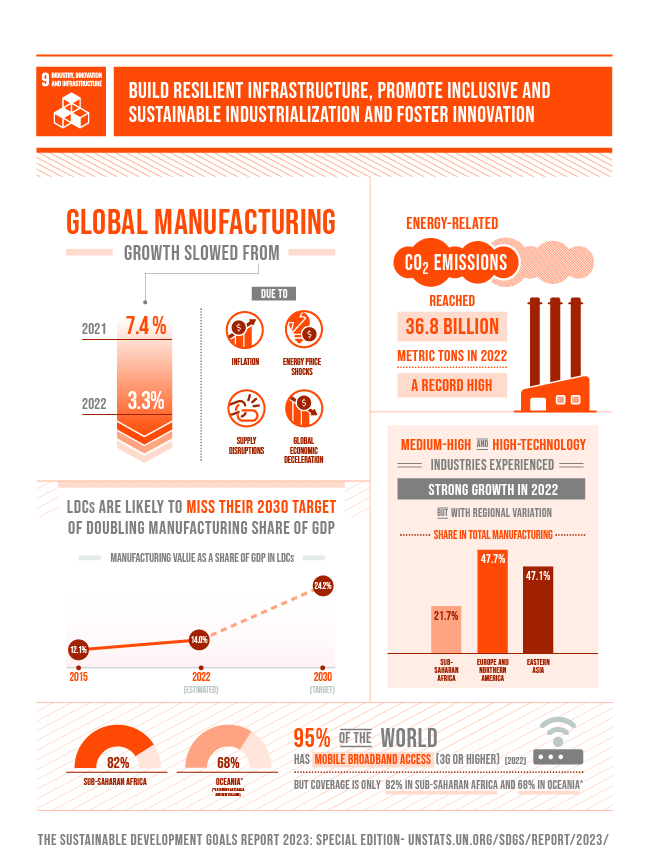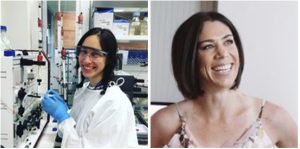Unit 3 Innovation: SDG9
Industry, Innovation and Infrastructure

Goal no. 9 of the 2030 Agenda for Sustainable Development aims to build resilient infrastructure, promote sustainable industrialisation and foster innovation.
Click on the arrows to reveal more information about SDG9. You don’t need to remember everything you read – the main thing is to get an overview of this Goal.
Information and targets reproduced under the terms and conditions of United Nations websites. Copyright (2023).
A reminder that links in this e-book do not open in a new tab. If you click on any of the links to a webpage, click the back button in your browser to return here.
Key vocabulary
Check that you know the meaning and the whole word family of these key words before you begin the Unit. (NOTE: there may be other versions of the word forms – these are the common forms in the context of SDG 9). Also notice some common collocations in bold in the ‘Why this goal? and ‘Targets’ sections above. Add any new words, word families or collocations that you would like to remember to your vocabulary book.
Verb Noun Noun person Adjective
. Infrastructure infrastructural
To industrialise industry/industrialisation industrialist industrial
To produce production producer productive
To innovate innovation innovator innovative
To retrofit retrofit/retrofitting retrofit
Introduction
In this unit you’ll learn about some innovative ways that the circular economy works, this time looking at the textile industry. You’ll read about how old clothes can be repurposed and hear about an app that encourages young people to trade second-hand clothes with each other, rather than throwing them away. You’ll learn about SDG9 Industry, Innovation and Infrastructure. By design, all SDGs overlap with one another. Use the sentence below as a prompt to make a list of which ones might overlap with SDG9 when considering the impact of the fashion industry (see the Welcome page for a list of all the SDGs).
The textile industry today is the second largest polluter of clean water, and many fashion companies exploit textile workers in the developing world.
In your local context…
- Are people employed as textile workers? If yes, what are the working conditions like?
- Is textile waste shipped to your country to be dealt with? If yes, what is your view on this?
- ‘Fast fashion’ is a term that refers to cheap clothing produced quickly and sold in large quantities in order to respond to the latest fashion trends. Is fast fashion an option in your context? If yes, have you thought much about the environmental impact of consuming goods in this way?
Data Visualisation – Build resilient infrastructure, promote inclusive and sustainable industrialization and foster innovation
The title of the infographic states the aims of SDG9, and the main body summarises the SDG9 section of the Sustainable Development Goals report 2023, showing progress (or lack of progress) towards the goal. Read the infographic and complete the tasks below. (Click here to see the infographic full screen).

Download the transcript here – Unit 3 Infographic
Reading – Circular fashion: turning old clothes into everything from new cotton to fake knees
Before you read – Vocabulary: waste in the textile industry
You saw in the infographic that one of the aims of SDG9 is to foster innovation. The reading examines innovative ways of taking old clothes and cotton waste and turning them into new products. Match these words that relate to using waste from the textile industry with the correct definition:
Skim read for main ideas & Read for detail
Make notes about the reading under each of the headings in the left-hand column. When you have finished download your notes to your own computer.
Circular fashion: turning old clothes into everything from new cotton to fake knees

Australia has a fashion problem. More than 500,000 tonnes of clothing waste is sent to landfill each year. But a new way of recycling could redirect some of our unwanted textiles from polluting the environment, by repurposing cotton waste into anything from new clothes to prosthetic knees.
Developed by our team at Deakin University, where we work on designing materials and processes for a circular economy, this solution for recycling textiles involves dissolving cotton and regenerating it into brand-new cellulose – a complex, strong carbohydrate with many industrial uses.
The cost of clothes
Textile waste consumes nearly 5% of all landfill space, and 20% of all freshwater pollution is a result of textile treatment and dyeing. Growing cotton requires harmful pesticides and fertilisers, and textile-manufacturing plants release hazardous waste into the nearby land.
Synthetic dyes also come at a cost to the environment. The dyeing process involves a lot of water, and not all of it is efficiently cleaned before re-entering our environment.
Waste water from textile dyeing can affect the entire water ecosystem. This is because some dyes don’t ever degrade in water. Those that do degrade produce harmful by-products – sometimes carcinogenic.
Importantly, despite the energy and resources used in the production process, not all cotton produced makes it into our clothes. Around 23.6 million tonnes of cotton is produced each year, but the weight of stems, leaves and lint from the plant amounts to 18-65% of each bale of cotton.
From what is left, even more cotton fibre is lost in the process of spinning cotton buds into yarn because some fibres break during spinning. Some of this raw material waste can be used to make products such as soaps, animal feed or cotton seed oil, but the rest is thrown away.
Wasted raw cotton material aside, it can take nearly 2,700 litres of water to produce a single cotton T-shirt and more than 7,600 litres to make a pair of jeans.
It’s no wonder that we want greener clothes!
How we’re closing the cotton circle
To counter the fast-fashion industry, circular fashion is taking off. Textile waste can now be recycled into usable products.
Cotton fibres are almost purely comprised of cellulose and can therefore be turned into other cellulose-based products.
At Deakin University’s Institute for Frontier Materials we have developed a chemical-based recycling process to produce high-quality, regenerated cellulose from cotton.
The regenerated cellulose can be used in many ways. It can be used in textile manufacturing again, in the production of cellophane and paper, insulation and filtration, or in biomedical applications such as drug delivery and tissue engineering.
Cotton waste has traditionally been recycled through a mechanical process that produces poorer quality recycled cotton. Only a small fraction of recycled cotton could be incorporated into new garments.
But our recycling process dissolves the cotton waste and regenerates it as cellulose. Even cotton blended fabrics, such as cotton-polyester blends, can be recycled in this process, so nothing goes to waste.
This regenerated cellulose has many different possible uses. It can be spun into a textile fibre similar to native cotton or used to make aerogels – synthetic, ultralight materials comprised of a network of micron-sized pores and nanoscale tunnels.
The aerogels produced from our recycling process can be moulded into a structure almost identical to cartilage in the joints of the body. We manipulate the size and distribution of tunnels to mould the aerogel within into synthetic cartilage with an ideal shape to replace damaged knee cartilage in arthritic patients.
While we haven’t used them in patients yet, we’ve found that the aerogels have a remarkable similarity to cartilage tissues when tested. They can replicate the type of lubrication mechanism used by cartilage in joints to protect against wear and damage.
Rescuing dyes
We can also shred cotton fabrics and mill them into coloured powders to dye new clothes. Since 2017, many Chinese factories that produced synthetic dyes for textiles were shut down following environmental inspections, highlighting the need for change in dyeing practices. We need new textile dyeing methods that save water, reduce pollutants, save energy and protect human health.
Our recycling process offers an environmentally friendly alternative. This process not only gives purpose to old clothing, but also eliminates much of the energy and water involved in the normal dyeing process.
We are rescuing denim and other cotton-based clothes from landfill to create cellulose fibres, aerogels and dyes from 100% of the waste.
Textile waste is a global challenge with significant environmental issues. We’ve created a recycling solution to tackle this pollution head-on.
NB This version of the article, with permission from the author, does not include the hyperlinks to supporting articles found in the original. Click the title for the full version of the text, published under a CC BY ND licence in The Conversation, which should be used for reference and sharing.
Speaking – Oral summary
Work with a partner:
- Without looking at your notes, give an oral summary to your partner of the key things you remember from the text about taking old clothes and cotton waste and turning them into new products.
- Tell your partner any new words you remember and give a definition. Add these new words to your vocabulary book.
Vocabulary – Compound words
- In Unit 2 you learned several compound adjectives. In the reading there are many compound, or two-part, words (compound nouns, compound adjectives and compound verbs). Read the sentences from the text and click on the compound word in each sentence:
- Remember that compound words are defined by what they do, rather than what they contain. In each sentence, decide if the compound word you have identified is a compound noun, a compound adjective, or a compound verb.
Pronunciation – Word stress in compound words
Focus on word stress in compound words
Although it can vary, as a general rule:
- compound nouns are usually stressed on the appropriate syllable of the first word (LANDfill).
- compound adjectives are usually stressed on the appropriate syllable of the second part of the compound (brand-NEW).
- compound verbs are usually stressed on the appropriate syllable of the first word (to HIGHlight).
Practice
Play the audio here.
Listen to these sentences and notice the word stress in the compound word. You’ll hear the sentence first followed by just the compound word. Listen and repeat the compound word.
Compound noun:
-
-
- clothing is sent to landfill 0o
-
Compound adjectives:
-
-
- brand-new cellulose o0
- textile-manufacturing plants oooo0oo
- a fast-fashion company o0
-
Compound verb:
-
-
- to highlight the need 0o
-
Listening – Depop sale: fashion retailers must move faster on sustainability (8 mins)

Before you listen – Prediction
- In the listening in Unit 1 you heard about the circular economy. Can you give a definition?
- In the reading in this Unit (‘Circular Fashion’) you learned about innovative ways of taking old clothes and cotton waste and turning them into new products – an example of the circular economy. Depop is a fashion app that is another innovative example of the circular economy. Can you guess how it works? Read the paragraph below and see if you were right.
Depop is a fashion marketplace app where people buy and sell used clothes that they don’t want any more. Apps like Depop are an innovative way to participate in the circular economy and this redistribution model is transforming fashion. The rise of consumer-to-consumer fashion redistribution platforms (where young people are both the sellers and the buyers) allows consumers to make the most of resources already in circulation. In the process they are making fashion more inclusive, diverse and less wasteful.
- In this listening, Dr. Ritch highlights the problem of fashion overconsumption in developed countries. How do you think this lifestyle choice affects people in developing countries?
- Do you think an app like Depop can help solve the problem of overconsumption? If so, how?
- Can you give a definition for the terms in bold in the paragraph? Use the context to help you guess.
Listen for main ideas
Play the audio here.
Listen for the specific information required to answer the questions on the cards. Stop and start the audio if you want to. From the flow of information identify just the relevant parts you need to answer the questions.
Download Unit 3 Listening – Transcript
Grammar – Gerunds and infinitives
- When you have two verbs in a sentence, the first verb dictates the form of the second one. Can you complete the quiz questions with the correct form?
2. The sentences below are taken from the reading and the listening. Read them and notice the form of the second verb 2 in the sentence:
Examples from the reading (Circular Fashion)
Verb + Gerund:
- We work on1 designing2 materials and processes for a circular economy.
- This solution involves1 dissolving2 cotton and regenerating it.
Examples from the listening (Depop)
Verb + Infinitive:
- Consumers want1 to buy2 more sustainable clothing.
- Some retailers encourage1 consumers to return2 unwanted clothing.
- Cos enables1 consumers to buy2 and sell used Cos clothing online.
- Consumers are not prepared1 to sacrifice2 their sense of identity.
Verb + infinitive without ‘to’:
- This may1 include2 redistribution markets, such as Depop.
- Retailers must1 act2 fast.
Grammar focus – Gerunds and infinitives
We use the infinitive without ‘to’:
- After a preposition
- After modal verbs can, could, may, might, will, shall, would, should, must, have to
We use the ‘to’ Infinitive after many common verbs including these:
- agree, demand, aim, manage, help, remember, offer, prefer, decide, etc.
We use the ‘ing’ form of the verb (also called the present participle or the gerund) after many common verbs including these:
- admit, deny, finish, practise, involve, consider, risk, etc.
Practice
Read the paragraph that summarises the listening. Complete the gaps in the summary paragraph by writing in the correct form of the verb in brackets:
Writing
In this Unit you’ve learned about some innovative ways of dealing with textile wate and how the circular economy works. The story of the Al Hannoun honey cooperative in Palestine, who are recycling beeswax, continues this theme.
Read the story of the honey cooperative and write a response to it that incorporates what you know about innovation, and SDG9 Industry, Innovation and Infrastructure. Write about:
- What the beekeepers need beeswax for.
- The machine that the beekeepers are using to recycle beeswax from old bee hives.
- How old beeswax is recycled and what the recycled beeswax is used for.
- Any other topic relevant to innovation or SDG9.
Innovating the Beekeeping Industry in Palestine with Recycled Beeswax
In 2017, fifteen (15) aspiring beekeepers joined forces to create the Al Hannoun honey cooperative to tap into the beekeeping industry in the State of Palestine. Within three years of operation, members of the cooperative have witnessed success and begun to seek environmentally friendly investment opportunities from abroad. By 2020, they secured an advanced beeswax recycling machine and tailored technical guidance to maximise its use through the FAO.
Prior to the introduction of the recycling machine, Al Hannoun relied on imported industrial beeswax to lure bees to visit wooden hives. Beeswax from old hives is usually damaged or destroyed and therefore could not be reused. With the machine, beeswax collected by the farmers from old hives can be recycled and upcycled. The machine melts, homogenizes and purifies the old beeswax and moulds to new ones. Thanks to this innovative technology, a large amount of used beeswax can be recycled and upcycled, to create new products like scented candles and other speciality items. As a result, the cooperative was able to save an estimated $5,840 (ILS 18,000) on beeswax.
Today, the cooperative has expanded to include 50 young members, all relying on beekeeping as a reliable source of income.
Department of Economic & Social Affairs Statistics Division (2022) ‘Bringing Data to Life: SDG impact stories from across the globe.’ Available at: https://unstats.un.org/sdgs/report/2022/SDG2022_Flipbook_final.pdf
Speaking
Read the summary below and discuss the questions that follow:
SDG9 Summary
Constructing new greener infrastructures, retrofitting or reconfiguring existing infrastructure systems and exploiting the potential of smart technologies can greatly contribute to the reduction of environmental impacts and disaster risks as well as the construction of resilience and the increase of efficiency in the use of natural resources.
Reproduced with kind permission of the UN Environment Programme. Copyright (2023). All rights reserved.
- You’ve learned about the work scientists are doing to find innovative ways to use waste textiles. How important do you think this research is?
- You’ve learned about the enormous amount of textile waste generated by the developed world. Are apps like Depop available to you? If yes, do you/would you use them instead of stimulating demand for new cotton products?
- Do you know of any innovative methods to deal with textile waste and to make better use of natural resources in your local context?
- Can you give a definition for the words in bold above?
A reminder that if you have access to the internet and are studying by yourself without other people to practice your spoken English with, you can use artificial intelligence (AI) to gain fluency practice. See here for instructions and prompts.
Here are some prompts related to this Unit:
- ‘Tell me some countries where people are employed as textile workers. I will ask you some questions about the working conditions in each country.’
- ‘Tell me about ‘fast fashion’ in [insert name of country]. What is the environmental impact of consuming goods in this way in that country? Ask me my opinion about ‘fast fashion’, and about the environmental impact.’
Looking ahead to unit 4
In Unit 4 you’ll continue learning about the textile industry and find out about SDG 14 – Life Below Water. At the beginning of this Unit you learned that the textile industry is the second largest polluter of clean water. Can you think of any links between fast fashion and water?
Use the menu bar on the left hand side of the screen to access Unit 4.

